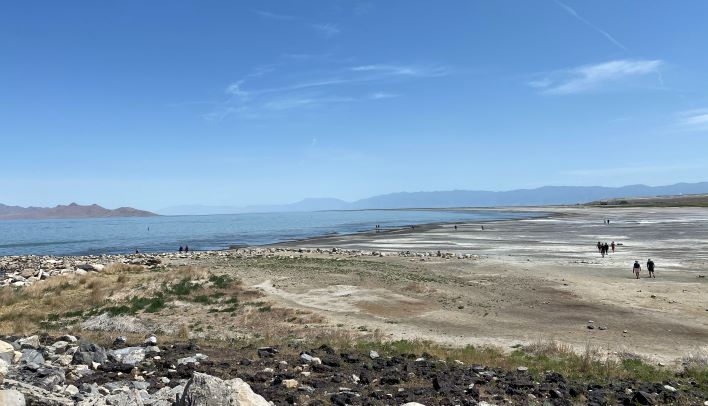A drying Great Salt Lake could mean increased dust, less snow, reduced lake access, elevated salinity, habitat loss, island bridges, more invasive plant growth and negative economic consequences to the state. Visit the links below to learn more about how the water, air and wildlife in and around the lake are being impacted.
Water

Hydrology & Levels
The U.S. Geological Survey monitors lake levels, salinity and groundwater data. Check out their interactive site that provides real-time data and information related to the lake and its watershed.

Salinity
For the unique Great Salt Lake ecosystem to thrive, salinity of the south arm should fall between 120 and 160 grams per liter (g/L). Ecosystems are impaired when salinity rises higher. In fall 2022, salinity reached 185 g/L.

Water Quality
Clearly defined water-quality goals ensure that regulatory decisions protect the lake’s vibrant ecology, beneficial uses and economic activities.

Groundwater Data Hub
Explore interactive maps and download comprehensive Utah groundwater data, including GIS datasets, well trends and research. Access studies and reports by the Utah Geological Survey and agency partners, covering a variety of groundwater-related topics such as Great Salt Lake, watershed restoration and more.
Air

Division of Air Quality
The Division of Air Quality safeguards and improves Utah’s air, land and water through balanced regulation.

Dust^2 Studies
A drying lakebed can increase the amount of airborne dust. Dust^2 tracks dust formation and impacts across the Intermountain West.
Wildlife

Birds
The Great Salt Lake is an avian oasis where as many as 12 million migratory birds visit annually to rest, refuel and breed.

Bison
The Division of State Parks manages between 550 and 700 free-roaming bison on Antelope Island State Park.

Microbialites
Microbialites provide food for brine fly larvae and brine shrimp, which provide food for birds. Low levels threaten them.

Brine Shrimp
Brine shrimp are crustaceans that inhabit saline waters around the world and are a valuable food source to migratory birds that congregate in and around the Great Salt Lake. Without this food source, the birds’ long migrations wouldn’t be possible.

Wetlands
The extensive marshes, mudflats and meadows surrounding the Great Salt Lake make up the highest concentration of vegetated wetlands in Utah and provide crucial stopover, wintering and nesting habitat for millions of shorebirds and waterfowl.
